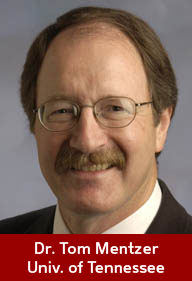This will mean more coordination between shippers to ensure a higher percentage of full truckload shipments – under-utilized trucks will no longer be economically viable for shippers or their carriers. It will also mean a growing emphasis on intermodal transportation to take advantage of the inherent fuel advantages afforded by rail. Continental networks of dedicated train schedules fed by local truck pickup and delivery will become more prevalent.
 To some degree, consumers will remember the credit crunch of this recession and will emerge more cautious about consumer spending. This is a normal “learning experience” from times of economic crisis. The children of the Great Depression spent their lives with a caution about borrowing, with a drive to keep back-up savings, and a distrust of the reliability of banks. The children of the 1970s spent their lives with a caution about inflation. Both affected their buying/investing habits for decades. The children of the present times, I believe, will carry for many years a caution about too much consumer credit. This will cause the recovery from the recession to be slow and drawn out, and will affect consumer spending well into the next decade. Supply chains derived from consumer markets will find product flow sluggish for years to come. To some degree, consumers will remember the credit crunch of this recession and will emerge more cautious about consumer spending. This is a normal “learning experience” from times of economic crisis. The children of the Great Depression spent their lives with a caution about borrowing, with a drive to keep back-up savings, and a distrust of the reliability of banks. The children of the 1970s spent their lives with a caution about inflation. Both affected their buying/investing habits for decades. The children of the present times, I believe, will carry for many years a caution about too much consumer credit. This will cause the recovery from the recession to be slow and drawn out, and will affect consumer spending well into the next decade. Supply chains derived from consumer markets will find product flow sluggish for years to come.
The consumptive nature of nations will shift over the next decade. Today, China views the United States and Europe as the great consumers of the products they manufacture, and this will remain an element of Chinese economics for years to come. However, it is insightful to think of China as the United States in 1952. For the years 1952 to 1970, the United States was building its infrastructure. The Interstate Highway and National Defense System was largely built. The advertising and broadcasting infrastructure around the advent of the television was largely built and began to fuel the “consumer economy.”
China looks much the same today. It is spending billions on logistics and communication infrastructure and will continue to do so for at least the next decade. Such spending creates income and wealth for its own citizens, income and wealth that will (for the next 15 to 20 years) fuel its own consumer economy. The "new normal" global supply chain will continue to see the flow of goods from China to the US and Europe, but more and more of that production capacity will soon flow to its own citizens, profoundly affecting global trade volumes. We may even see the day when the US and Europe produce a larger share of what is consumed in China.
Finally, the current recession, temporarily, has taken much of the stress off US port capacity. However, with the eventual world recovery, US ports will once again face serious capacity issues. We simply do not have the number, size, or efficiencies necessary to bring into the US the volume of goods we demand. Mexico (and to a lesser degree, Canada) is aware of this and is expanding its port capacities in anticipation of this eventuality. In the "new normal" US supply chains, we will see more and more product flow not West-to-East, but South-to-North as Mexico increases its capacity to receive ships and move their cargo North to US redistribution points. This will require infrastructure improvements in Mexican rail, US rail, and the capacity of US redistribution points.
The "new normal" supply chains of the future will be drastically different than what we have experienced in the past. This is a normal evolution of a global economy. However, this also creates a considerable opportunity for the forward-thinking supply chain executive. In chaos, there is opportunity. Those who are successful in the future "new normal" supply chains will watch these trends and build supply chain capabilities to take advantage of them. As it has always been, herein lies the foundations of competitive advantage.
Dr. Jim Tompkins, Tompkins Associates
I get different answers to this topic depending upon the perspective I take. The three perspectives that come to mind are:
1. Big picture;
2. Supply chain view; and
3. Supply chain mega processes.
Let me address the new supply chain norm from all three perspectives.
First, from a big-picture perspective, I believe:
1. The new norm for the supply chain is that there is no new norm. Or, stated differently, the new norm is that the pace of change is so rapid that the new norm is that everything is changing and will continue to change. This leads to the supply chain requirement that supply chain success will only be achieved when supply chains have substantial flexibility and modularity.
 2. Another take on the "there is no new norm to supply chains" has to do with the diversity of supply chains. Each geography, each industry, and even each company has unique supply chain requirements. Thus, as companies refine and adapt their supply chains, they continue to move further and further from what used to be considered "norm." 2. Another take on the "there is no new norm to supply chains" has to do with the diversity of supply chains. Each geography, each industry, and even each company has unique supply chain requirements. Thus, as companies refine and adapt their supply chains, they continue to move further and further from what used to be considered "norm."
3. Clearly, a new norm that has evolved over the recent economic crisis is that supply chains have become more and more complex. With the globalization, technology, customer requirements, mergers and acquisitions, and the requirement of speed, this will not change. However, what must change is the need to simplify in areas where simplification can be done so that the complexity of the supply chain can be managed. So, the new norm is rationalization of suppliers, clustering of suppliers, rationalization of carrier base, reduction of the number of LSPs, utilization of hubs, etc. Simplify, simplify, simplify.
4. Clearly, a new norm has to do with uncertainty. Senior supply chain leaders have not been through a recession like this, where many of the norms they have come to expect are being overturned and are no longer true. This uncertainty is causing a real challenge with the decision process, as organizational uncertainty is creating grid lock in many executive suites. A new norm must evolve to move forward even though we are dealing with uncertainty.
5. Lastly, from a big-picture perspective, the new norm is that the supply chain is undergoing a new level of scrutiny. Board's and the C-level clearly now understand the importance of the supply chain to the long-term success of their organization. The companies who have weathered the Great Recession storm have a higher level of understanding and performance expectation of the supply chain. Supply chain has evolved to a phrase folks throw around to a new norm of being a critical priority and focus for future organizational success.
The second perspective on the topic of the new norm of supply chains results from my viewing the supply chain from the different views of Strategy, People, Processes and Technology. The new supply chain norms from these four views include:
STRATEGY: A new norm is that Business Strategy must go in front of Supply Chain Strategy and Supply Chain Strategy must go in front of Supply Chain Structure. Once the Business Strategy is well defined, Supply Chain Strategies must be built for:
- Capacity and bottlenecks;
- Labor availability;
- Supply chain knowledgeable resources;
- Regulations for the environment, security, transportation, etc,;
- Changes to supply chain costs – sourcing, fuel, LSPs, etc.;
- Manufacturing and distribution networks; and
- Risks and threats.
PEOPLE: A new norm for supply chain is that there will be fewer people in your organization; the people you have will be smarter, better trained, more accustomed to working in teams, more capable of working on cross-functional tasks, more open to outsourcing and more focused on results.
PROCESSES: A new norm for supply chain is more process teams and fewer departmental organizations. Fewer silos and boundaries limiting organizational and supply chain performance. A much more rigorous focus on benchmarking, best practices and performance metrics across all supply chain processes.
TECHNOLOGIES: A new norm for supply chain will be more robust supply chain definition of requirements for the supply chain, a greater focus on the quality of supply chain data and a greater acceptance of SaaS. Enhanced supply chain visibility and openness to supply chain information will make collaboration much more valuable.
The last perspective on the topic of the new norm of supply chains results from viewing the Mega supply chain processes of Plan-Buy-Make-Move-Store-Sell. The new supply chain norms from these processes include:
PLAN: More flexible, more global and better tools for "what-if's";
BUY: Better customer/supplier relationships, greater global diversity and more focus on total delivered cost;
MAKE: More outsourcing, more Lean supply chain focus and less labor-intensive;
MOVE: More preferred carriers, more contracts and less spot buying, more intermodal partnerships for door-to-door service and more trade compliance regulations;
STORE: More automation, more crossdocking and more flow of goods as opposed to storage of goods; and
SELL: More focus on the consumer value, more demanding consumers, more internet shopping, higher service levels and fewer retail out-of-stocks.
So, the new supply chain norm looks nothing like the old norm. Hang onto your hats. Only the organizations with strong, dynamic supply chains will make it to the future.
Any reaction to Mentzer and Tomkins' predictions? What do you think will be the new supply chain normal? Let us know your thoughts at the Feedback button below.
SCDigest is Twittering!
Follow us now at https://twitter.com/scdigest |